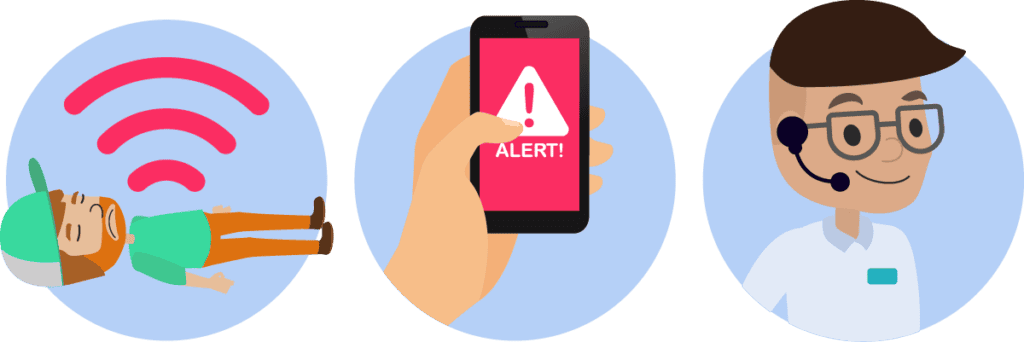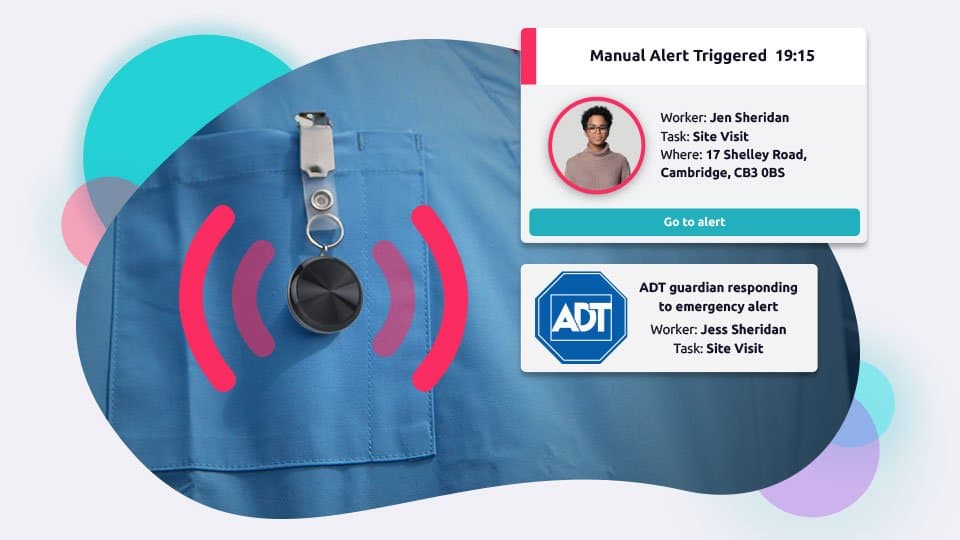
A man down (or “fall detection”) alarm can detect if a user has taken a serious fall and will trigger an alert.
Although fall detection devices are popular for personal and professional use, when we talk about man down alarms, we tend to mean systems used to protect people while they are working.

Once triggered, a man down alarm can send for help in three ways:

Man down alarms are most helpful for the following people:
Slips trips and falls account for more than half of all in-work industries, so this is relevant to anyone, but particularly for those who are always on their feet, carry burdens, or work on uneven ground.
Waiting staff, builders, carers, factory and warehouse workers, and those who work outside are all good examples.
Working with the public can always come with a risk. When dealing with strangers, you never know how they’ll act, and they may not follow the same codes or norms as other employees.
This can affect all sorts of workers, including waiting staff, shop workers, health and social care workers, security guards, and salespeople. The risk can be even greater if the person is working during late or unsociable hours.
There are certain medical conditions which may put a user at greater risk of having a fall or injury during an otherwise typical day.
From heart problems to epilepsy, there may be many conditions that, while fine on the day-to-day, might require a little more preparation.
After all, if someone is working in a low-risk role, (such as desk-based admin), and they have an epileptic seizure, they may come to some harm and may require assistance. Being aware of these needs can help make sure everyone has the support to work safely.

Man down alarms work by detecting a serious fall, and raising some sort of alarm.
Different devices work in different ways but, as an example, we’ll look at how Safepoint’s man down alarm works.
With Safepoint, users wear a smart panic alarm that pairs with their phone (a bit like wireless headphones).
When a user takes a serious fall, Safepoint’s man down device detects changes in speed and height, to intelligently detect a fall.
Once detected, the device sends a signal to the user’s phone which will kick into an emergency mode. A smart-alert is then sent out with the user’s name, live location and any relevant medical data.
When a man down alert is sent by Safepoint’s system, it can be sent directly to the user’s trusted contacts and/or Safepoint’s 24/7 emergency response team.
If the alert is sent to the user’s trusted contacts, they will be notified on their phone (as well as by email and text) and will be able to pull up the user’s live location and other safety data. They can then use this info to investigate the situation.
Alternatively, those who use Safepoint’s 24/7 emergency response service will have their alert sent to ADT’s purpose-built Alarm Receiving Centre.
As Safepoint is the only solution of its kind to be partnered with ADT, this means users will have exclusive access to one of the world’s oldest and most respected security companies.
This means that, if a Safepoint user takes a fall (any time, day or night) ADT’s fully trained and accredited response team will be there for them. These fully-accredited professionals will first attempt to get direct contact with the user, before reaching out to the user’s trusted contacts.
At all times, they will be monitoring the user’s live locations and safety status through Safepoint’s intelligent system.
If, at any point, Safepoint’s response team at ADT feel that there is a genuine emergency, they are trained and qualified to work with the emergency services for a quick and efficient response.
If you go to other sections of our website, you may notice that we don’t tend to use the term “man down”. We tend to find that “fall-detection” is a more descriptive and helpful term.
Whether you prefer “man down alarms” or “fall-detection alarms”, we hope this article has helped you understand what they’re for, and how they can help keep your team safe!
Award-winning safety management tools and a fully accredited response team.